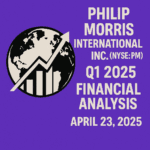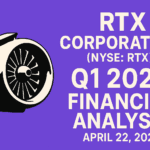PepsiCo, Inc. (NASDAQ: PEP)
Q1 2025 Financial Analysis | April 24, 2025
Executive Summary
PepsiCo, Inc. (NASDAQ: PEP) reported resilient first-quarter 2025 results amid increasingly dynamic and complex geopolitical and macroeconomic conditions. While reported revenue declined 1.8% to $17.9 billion, organic revenue grew 1.2%, demonstrating the company's underlying strength despite global headwinds. PepsiCo has updated its full-year 2025 guidance, maintaining its low-single-digit organic revenue growth forecast but revising its core constant currency EPS expectations to approximately even with the prior year (previously expected mid-single-digit growth). The company cited increased supply chain costs related to global trade developments, elevated macroeconomic volatility, and a subdued consumer backdrop as key factors behind the revised outlook.
Q1 2025 Highlights
Financial Performance
PepsiCo's reported revenue for the first quarter of 2025 decreased 1.8% year-over-year to $17.9 billion, primarily impacted by a 3% foreign exchange headwind. On an organic basis, which adjusts for foreign exchange, acquisitions, and divestitures, revenue grew 1.2%, driven by effective net pricing of approximately 3% that helped offset a 2% organic volume decline. The company's reported gross profit remained essentially flat at $10.0 billion, though gross profit margin improved by 100 basis points to 55.8%, reflecting a positive price/mix and productivity savings.
Operating profit decreased 5% to $2.6 billion, while operating margin contracted 50 basis points to 14.4%, mainly due to higher supply chain costs and increased selling, general and administrative expenses. Net income declined 10.2% to $1.8 billion, resulting in reported EPS of $1.33, down 10% from $1.48 in Q1 2024. Core EPS, which excludes certain items affecting comparability, was $1.48, representing an 8.1% decline from the prior year. On a constant currency basis, core EPS decreased 4%, reflecting the significant impact of foreign exchange headwinds on the company's results.
The company's performance indicates resilience in a challenging macroeconomic environment, with pricing actions helping to offset volume pressures and currency headwinds. However, the growing impact of global trade developments on supply chain costs and the subdued consumer backdrop in many markets are presenting new challenges for PepsiCo's profitability.
Segment Performance
| Segment | Revenue ($B) | Reported Growth | Organic Growth | Operating Profit Growth | Core Constant Currency Operating Profit Growth |
|---|---|---|---|---|---|
| PepsiCo Foods North America | $6.2 | -1% | -2% | 2% | -7% |
| PepsiCo Beverages North America | $5.9 | 0% | 1% | -10% | 14% |
| International Beverages Franchise | $0.8 | 3% | 7% | 6% | 12% |
| Europe, Middle East and Africa | $2.4 | -2% | 8% | 3% | 13% |
| Latin America Foods | $1.7 | -12% | 3% | -18% | -2% |
| Asia Pacific Foods | $1.0 | -2% | -1% | -9% | -6% |
PepsiCo's segment performance in Q1 2025 reflected varying regional dynamics and category trends. The company's international segments generally showed stronger organic growth, while North American businesses faced more challenges:
PepsiCo Foods North America (PFNA) experienced a 1% decline in reported revenue and a 2% drop in organic revenue, primarily due to a 3% decrease in volume partially offset by 1% effective pricing growth. Despite the revenue decline, reported operating profit increased 2%, though core constant currency operating profit decreased 7%, indicating underlying challenges in this segment.
PepsiCo Beverages North America (PBNA) reported flat revenue growth but achieved 1% organic revenue growth, driven by 2% effective pricing that offset a 1% volume decline. While reported operating profit decreased 10%, core constant currency operating profit grew 14%, demonstrating the positive impact of pricing actions and productivity improvements once one-time items are excluded.
International Beverages Franchise (IB Franchise) was a standout performer with 3% reported revenue growth and 7% organic growth, driven by 5% volume growth and 2% effective pricing. Both reported operating profit and core constant currency operating profit showed strong growth at 6% and 12%, respectively.
Europe, Middle East and Africa (EMEA) faced significant currency headwinds, with reported revenue declining 2% but organic revenue growing 8%. This strong organic performance was driven by 16% effective pricing that offset an 8% volume decline. Core constant currency operating profit increased 13%, showcasing the region's effective management of inflationary pressures.
Latin America Foods (LatAm Foods) reported a 12% revenue decline but achieved 3% organic growth when adjusting for a substantial 15% currency impact. The segment's reported operating profit decreased 18%, with core constant currency operating profit down 2%, reflecting challenging macroeconomic conditions in the region.
Asia Pacific Foods saw a 2% decrease in reported revenue and a 1% decline in organic revenue, with reported operating profit down 9% and core constant currency operating profit down 6%. This segment benefited from 3.5% volume growth but was negatively impacted by a 4% decrease in effective pricing.
Overall, the segment results underscore PepsiCo's ability to drive pricing in most regions to offset inflation, though volume remains under pressure in several markets due to consumer sensitivity to higher prices and broader macroeconomic factors.
Volume & Category Trends
Convenient Foods
Regional Volume Performance
- North America: -1%
- EMEA: -9%
- Latin America: -0.5%
- Asia Pacific: 3%
- Total Convenient Foods: -3%
Beverages
Regional Volume Performance
- North America: -3%
- EMEA: -4%
- International Beverages Franchise: 3%
- Total Beverages: 0%
PepsiCo's volume performance in Q1 2025 showed continued pressure across most regions, particularly in its Convenient Foods business. Overall, Convenient Foods volume declined 3% while Beverages volume was flat year-over-year. These trends reflect ongoing consumer spending caution in many markets as well as the impact of PepsiCo's pricing actions to offset inflation.
In Convenient Foods, North America experienced a modest 1% volume decline, while EMEA saw a more substantial 9% drop, indicating greater consumer sensitivity to pricing in European markets. Latin America was relatively stable with a slight 0.5% volume decrease, while Asia Pacific demonstrated strength with 3% volume growth, bucking the global trend.
In Beverages, North America volumes declined 3%, reflecting ongoing category softness and consumer price sensitivity. EMEA beverage volume decreased 4%, consistent with broader consumption trends in the region. The International Beverages Franchise was a bright spot with 3% volume growth, driven by effective commercial strategies and relatively stronger consumer spending in some of its markets.
The contrasting performance between Beverages and Convenient Foods, particularly in international markets, suggests that PepsiCo may need to recalibrate its pricing and promotional strategies in certain categories and regions to stimulate volume growth while maintaining the appropriate balance with profitability. Management indicated plans to address performance improvements in North America while continuing the successful expansion of its international business.
Balance Sheet & Cash Flow
PepsiCo's balance sheet and cash flow performance in Q1 2025 demonstrated the company's typically seasonal cash usage pattern in the first quarter, though with some improvement over the prior year. Operating cash flow was negative $973 million, a slight improvement from the negative $1.04 billion in Q1 2024. This seasonal outflow is consistent with PepsiCo's business cycle, as the first quarter typically sees working capital build ahead of the peak summer selling season.
Capital expenditures decreased slightly to $603 million from $614 million in the prior year, reflecting disciplined capital allocation. The company returned $2.07 billion to shareholders during the quarter, including $1.88 billion in dividends and $183 million in share repurchases. This represents an increase in total shareholder returns compared to Q1 2024, consistent with PepsiCo's commitment to returning cash to shareholders.
PepsiCo ended the quarter with a strong liquidity position, including $8.27 billion in cash and cash equivalents and $314 million in short-term investments. Total debt increased to $48.52 billion, including short-term debt of $9.1 billion and long-term debt of $39.4 billion. During the quarter, the company issued $3.51 billion in new long-term debt while repaying $1.54 billion of maturing debt.
For full-year 2025, PepsiCo continues to expect approximately $8.6 billion in total cash returns to shareholders, comprised of $7.6 billion in dividends and $1.0 billion in share repurchases. The company's 5% dividend increase announced for the June 2025 payment marks its 53rd consecutive annual increase, underscoring PepsiCo's commitment to consistent dividend growth even amid challenging operating conditions.
Outlook & Guidance
Updated FY2025 Guidance
Headwinds & Challenges
Management Commentary
"We are actively planning mitigation actions to address these higher supply chain costs where possible, while at the same time being conscious to minimize disruption to our operations, our consumer and customer relationships, and the long-term health of our business. Accordingly, we will continue building upon the successful long-term expansion of our international business, while also taking actions to improve performance in North America. Our multi-year productivity initiatives will help fund disciplined commercial investments and aid our profitability." - Ramon Laguarta, Chairman and CEO
PepsiCo has updated its 2025 financial guidance, maintaining expectations for low-single-digit organic revenue growth but revising its core constant currency EPS outlook. The company now expects core constant currency EPS to be approximately even with the prior year, a significant change from the previously projected mid-single-digit growth. This updated guidance implies a 3% decline in core EPS for 2025 compared to 2024 core EPS of $8.16, when accounting for an anticipated 3% foreign exchange translation headwind.
The revision in EPS guidance primarily stems from expectations of higher supply chain costs related to global trade developments (particularly tariffs), combined with continued macroeconomic volatility and subdued consumer sentiment in many markets. Despite these challenges, PepsiCo remains committed to returning approximately $8.6 billion to shareholders in 2025, including $7.6 billion in dividends and $1.0 billion in share repurchases.
Management has indicated that the company is developing mitigation strategies to address higher supply chain costs while minimizing disruption to operations and customer relationships. These efforts include continuing the successful expansion of international businesses, improving performance in North America, and leveraging multi-year productivity initiatives to fund commercial investments and support profitability.
The guidance update suggests that PepsiCo anticipates a challenging operating environment throughout 2025, with limited ability to fully offset cost increases through pricing and productivity in the near term. The company appears to be prioritizing long-term business health and relationships over aggressive short-term actions that might further pressure volume growth or damage customer partnerships.
Risks & Opportunities
Risks
Opportunities
Conclusion
Strengths
- Organic revenue growth of 1.2% despite challenging conditions
- Strong pricing execution across most regions
- Solid performance in International Beverages Franchise (+7% organic growth)
- Gross margin improvement to 55.8% (+100 bps)
- 53rd consecutive annual dividend increase
Focus Areas
- Addressing higher supply chain costs due to trade policies
- Improving North American business performance
- Managing currency translation impact on international results
- Balancing pricing and volume growth in a subdued consumer environment
- Executing productivity initiatives to support profitability
Summary
PepsiCo delivered resilient performance in Q1 2025 amid increasingly dynamic and complex geopolitical and macroeconomic conditions. While reported revenue declined 1.8%, organic revenue grew 1.2%, demonstrating the company's ability to execute pricing strategies to partially offset volume pressures and currency headwinds. The revised outlook for 2025, particularly the downward adjustment to core EPS expectations, reflects the growing impact of global trade policies on supply chain costs and continued consumer caution across many markets.
The company's international businesses, particularly the International Beverages Franchise and European operations, showed strong organic growth, while North American segments faced more significant challenges. Management's focus on addressing these performance disparities while minimizing disruption to operations and customer relationships indicates a balanced approach to near-term issues while safeguarding long-term business health.
Looking ahead, PepsiCo's multi-year productivity initiatives and disciplined commercial investments will be critical to navigating the current challenging environment while positioning the company for future growth. The sustained commitment to shareholder returns, exemplified by the 53rd consecutive annual dividend increase, underscores management's confidence in PepsiCo's long-term business fundamentals despite near-term headwinds.
Source: PepsiCo Q1 2025 Earnings Release






